AMD Radeon HD 7970 Review: 28nm And Graphics Core Next, Together As One
by Ryan Smith on December 22, 2011 12:00 AM EST- Posted in
- GPUs
- AMD
- Radeon
- ATI
- Radeon HD 7000
Crysis: Warhead
Kicking things off as always is Crysis: Warhead. It’s no longer the toughest game in our benchmark suite, but it’s still a technically complex game that has proven to be a very consistent benchmark. Thus even 4 years since the release of the original Crysis, “but can it run Crysis?” is still an important question, and the answer continues to be “no.” While we’re closer than ever, full Enthusiast settings at a 60fps is still beyond the grasp of a single-GPU card.
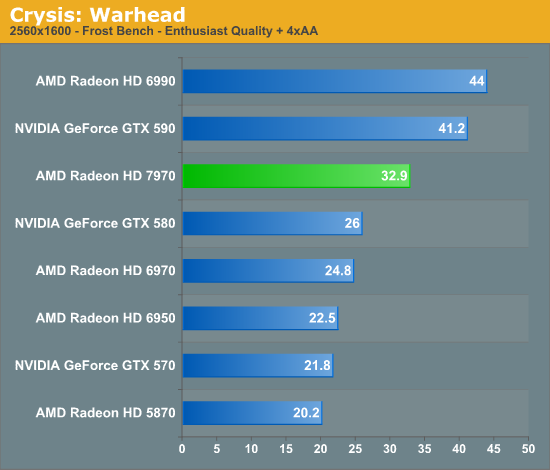

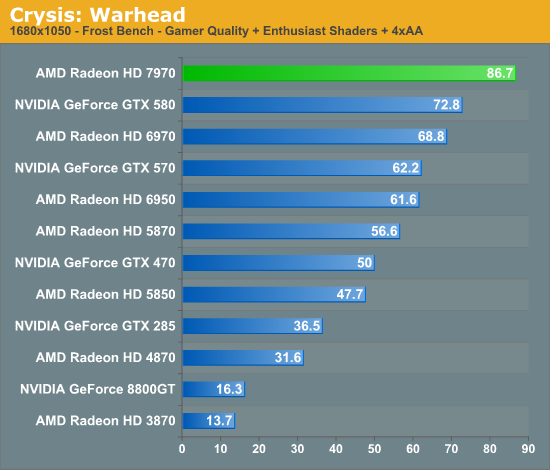
This year we’ve finally cranked our settings up to full Enthusiast quality for 2560 and 1920, so we can finally see where the bar lies. To that extent the 7970 is closer than any single-GPU card before as we’d imagine, but it’s going to take one more jump (~20%) to finally break 60fps at 1920.
Looking at the 7970 relative to other cards, there are a few specific points to look at; the GTX 580 is of course its closest competitor, but we can also see how it does compared to AMD’s previous leader, the 6970, and how far we’ve come compared to DX10 generation cards.
One thing that’s clear from the start is that the tendency for leads to scale with the resolution tested still stands. At 2560 the 7970 enjoys a 26% lead over the GTX 580, but at 1920 that’s only a 20% lead and it shrinks just a bit more to 19% at 1680. Even compared to the 6970 that trend holds, as a 32% lead is reduced to 28% and then 26%. If the 7970 needs high resolutions to really stretch its legs that will be good news for Eyefinity users, but given that most gamers are still on a single monitor it may leave AMD closer to 40nm products in performance than they’d like.
Speaking of 40nm products, both of our dual-GPU entries, the Radeon HD 6990 and GeForce GTX 590 are enjoying lofty leads over the 7970 even with the advantage of its smaller fabrication process. To catch up to those dual-GPU cards from the 6970 would require a 70%+ increase in performance, and even with a full node difference it’s clear that this is not going to happen. Not that it’s completely out of reach for the 7970 once you start looking at overclocking, but the reduction in power usage when moving from TSMC 40nm to 28nm isn’t nearly large enough to make that happen while maintaining the 6970’s power envelope. Dual-GPU owners will continue to enjoy a comfortable lead over even the 7970 for the time being, but with the 7970 being built on a 28nm process the power/temp tradeoff for those cards is even greater compared to 40nm products.
Meanwhile it’s interesting to note just how much progress we’ve made since the DX10 generation though; at 1920 the 7970 is 130% faster than the GTX 285 and 170% faster than the Radeon HD 4870. Existing users who skip a generation are a huge market for AMD and NVIDIA, and with this kind of performance they’re in a good position to finally convince those users to make the jump to DX11.
Finally it should be noted that Crysis is often a good benchmark for predicting overall performance trends, and as you will see it hasn’t let us down here. How well the 7970 performs relative to its competition will depend on the specific game, but 20-25% isn’t too far off from reality.
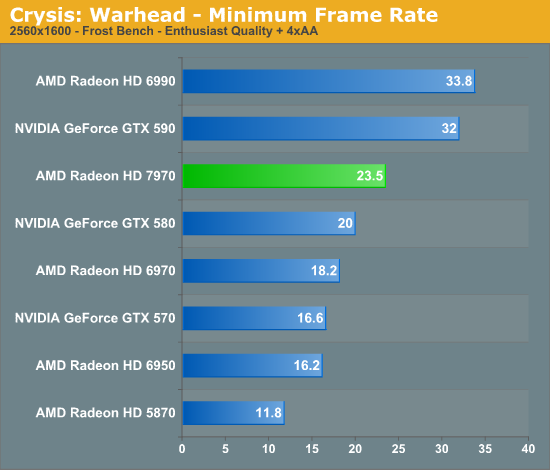
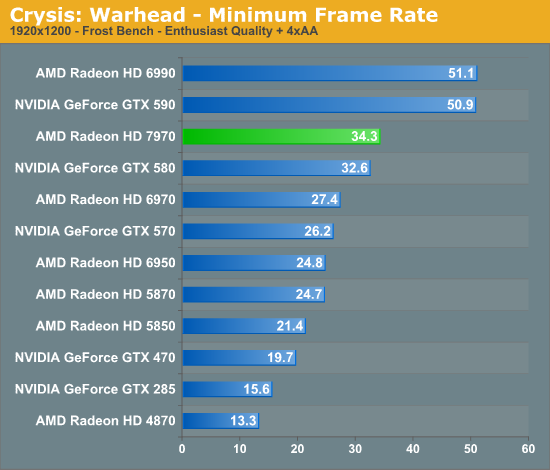
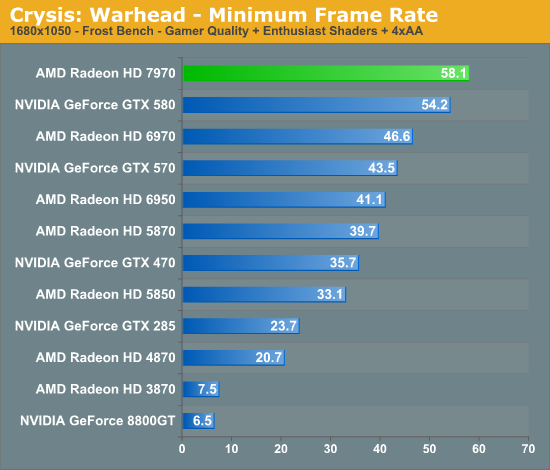
Looking at our minimum framerates it’s a bit surprising to see that while the 7970 has a clear lead when it comes to average framerates the minimums are only significantly better at 2560. At that resolution the lowest framerate for the 7970 is 23.5 versus 20 for the GTX 580, but at 1920 that becomes a 2fps, 5% difference. It’s not that the 7970 was any less smooth in playing Crysis, but in those few critical moments it looks to be dipping a bit more than the GTX 580.
Compared to the 6970 on the other hand the minimum framerate difference is much larger and much more consistent. At 2560 the 7970’s minimums are 29% better, and even at lower resolutions it holds at around 25%. Clearly even with AMD’s new architecture their designs still inherit some of the traits of their old designs.










292 Comments
View All Comments
SlyNine - Friday, December 23, 2011 - link
Not really, If Nvidia didn't handicap the CPU version of physx so bad than I'd be fine with it, But Nvidia purposely made the CPU version of phsyx worse totally gimped.CeriseCogburn - Thursday, March 8, 2012 - link
I agree, but that's the way it guy. The amd fans don't care what they and their reviewers pull, and frankly the reviewers would recieve death threats if they didn't comply with amd fanboy demands....So when nvidia had ambient occlusion active for several generations back in a driver add, we were suddenly screamed at that shadows in games suck.... because of course amd didn't have that feature...
That's how the whole thing is set up - amd must be the abused underdog, nvidia must be the evil mis-implementer, until of course amd gets and actual win, or even any win even with 10% IQ performance cheat solidly in place, and any other things like failed AA, poor tessellation performance, no PhysX, etc, etc, etc...
We just must hate nvidia for being better and of course it's all nvidia's fault as they are keeping the poor red radeon down....
If amd radeon has " a perfectly circular algorithm " and it does absolutely nothing and even worse in all games, it is to be praised as an advantage anyway.... and that is still happening to this very day... we ignore shimmer until now, when amd 79xx has a fix for it.... etc..
Dude, that's the way it is man....
Nvidia is the evil, and they're keeping the radeon down...
They throw around money too ( that's unfair as well - and evil ...)
See?
So just pretend anything radeon cannot do that nvidia can doesn't count and is bad, and then make certain nvidia is cut down to radeon level, IQ cheat, no PhysX, AA not turned on, Tesselation turned down, default driver hacks left in place for amd, etc....
Then be sure to cheer when some price perf calc ignoring all the above shows a higher and or lower and card to have a few cents advantage... no free game included, no eyefinity cables... etc.
Just dude... amd = good / nvidia=evil ...
Cool ?
shin0bi272 - Thursday, December 22, 2011 - link
Since I cant edit my comments I have to post this in a second comment instead.According to the released info, Nvidia’s Next Gen flagship GK-100/GK-112 chip which will feature a total f 1024 Shaders (Cuda Cores), 128 texture units (TMUs), 64 ROP’s and a 512-bit GDDR5 Memory interface. The 28nm Next Gen beast would outperform the current Dual chip Geforce GTX590 GPU.
shaboinkin - Thursday, December 22, 2011 - link
Can someone tell me why GPUs tend to have much more transistors than a CPU? I never knew why.Boushh - Thursday, December 22, 2011 - link
Basically it has to do with the difference between programs (= CPU instructions) and graphics (= pixels):A program consists of CPU intructions, many of these instructions depend on output from the previous instruction, Therefore adding more pipelines that can work on the instructions doen't realy work.
A picture consists of pixels, these can be processed in parrallel. So if you double the number of pipelines (= pixels you can work on at the same time), you double the performance.
Therefore CPU's don't have that many transistors. In fact, most transistors in a CPU are in the cache memory not in the actual CPU cores. And GPU's do.
Of course this is hust a simple explenation, the through is much much more complex ;-)
Boushh - Thursday, December 22, 2011 - link
That last line should read:'Of course this is just a simple explanation, the reality is much much more complex'
Reminds me to yet again vote for an EDIT button !!!! Maybe as a christmas present ? PLEASE !!!
shaboinkin - Thursday, December 22, 2011 - link
Interesting...Do you know of a site that goes into the finer details?
Mishera - Wednesday, December 28, 2011 - link
If you're looking for something to specifically answer you question the checking different tech sites. I think realworldtech addressed tis to a degree. Jon Stokes at arstechnica from what I heard wrote some pretty good articles on chip design as well. But if it's a question on chip architecture, reading some textbooks is your best bet. I asked a similar question in the forums before and got some great responses just check my posts.I add to what Boushh said in that for the type of information they process, it's beneficial to have more performance (and not just for graphics). That's why Amd has been pushing to integrate the gpu into the CPU. That's also to a degree show the different philosophy right now between intel and Amd in multicore computing (or the difference between Amd's new gpu architecture vs their previous one).
What it comes down to is optimizing chip design to make use of programs, vice versa. There really is now absolute when dealing with this.
MrSpadge - Thursday, December 22, 2011 - link
It's not like - as stated several times in the article - AMD is wrong about the power target of the HD7970, if they mean the PowerTune limit. Think of it as "the card is built to handle this much heat, and is guaranteed not to exceed it". That doesn't forbid drawing less power. And that's exactly what the HD6970 does: it's got the same "power target", but it uses less of its power budget than the HD7970.Like CPUs, whose real world power consumption is often much less than the TDP.
MrS
Ryan Smith - Thursday, December 22, 2011 - link
PowerTune is a hard cap on power consumption. Given a sufficient workload (i.e. FurMark or OCCT), you can make the card try to consume more power than it is allowed, at which point PowerTune kicks in. Or to put this another way, PowerTune doesn't kick in unless the card is at its limit.PowerTune kicked in for both the 6970 and 7970. In which case both cards should have be limited to 250W.